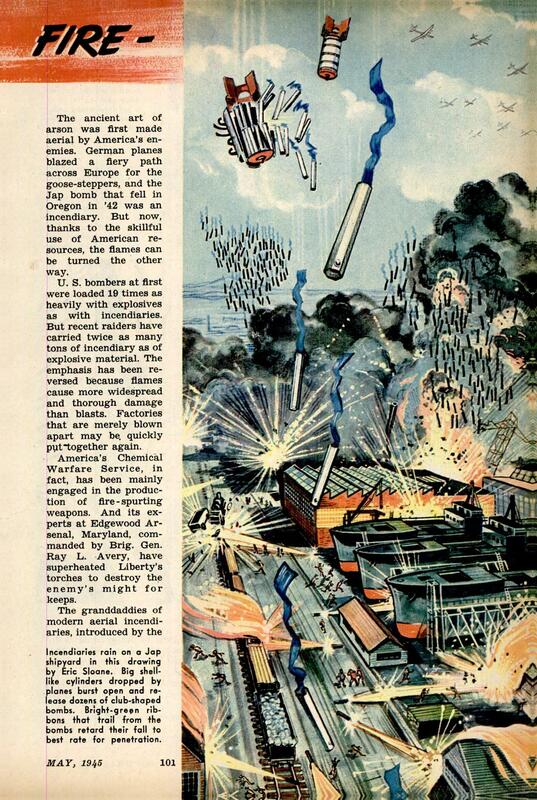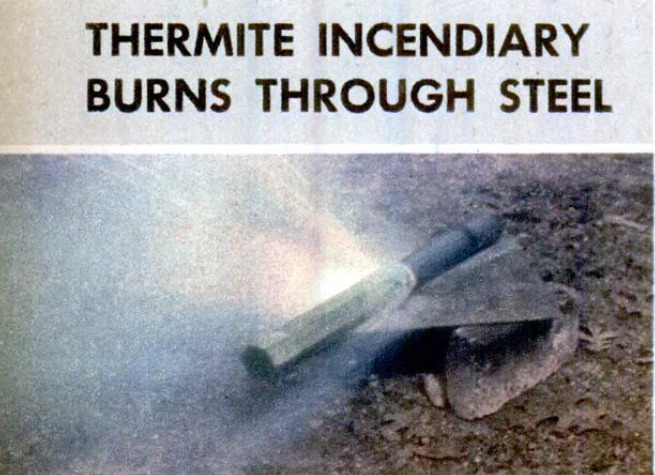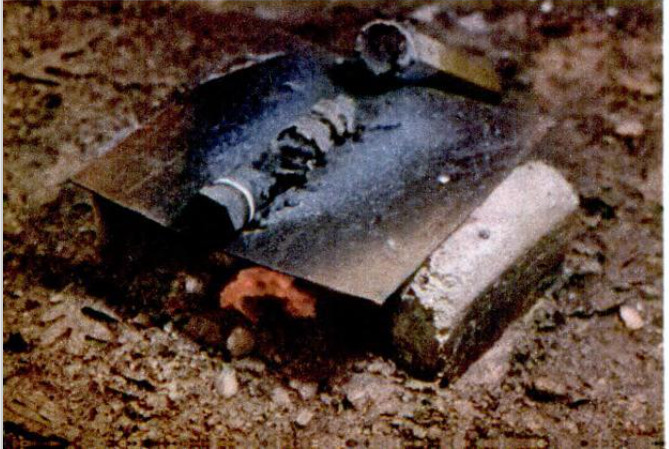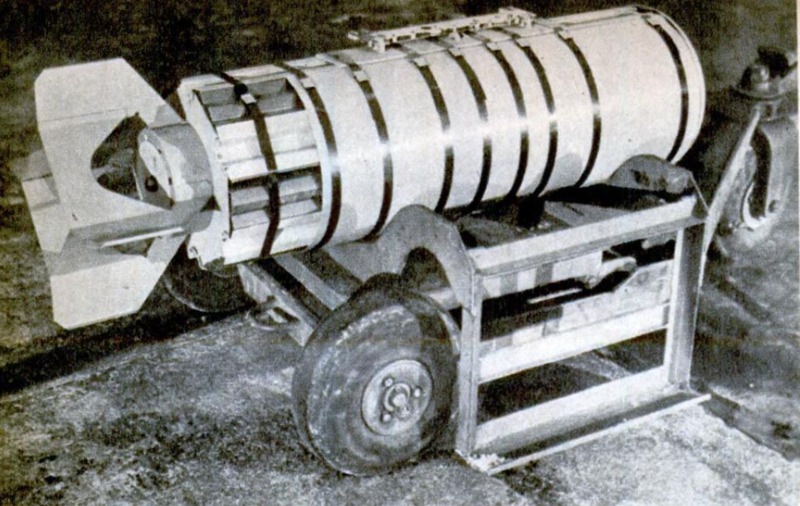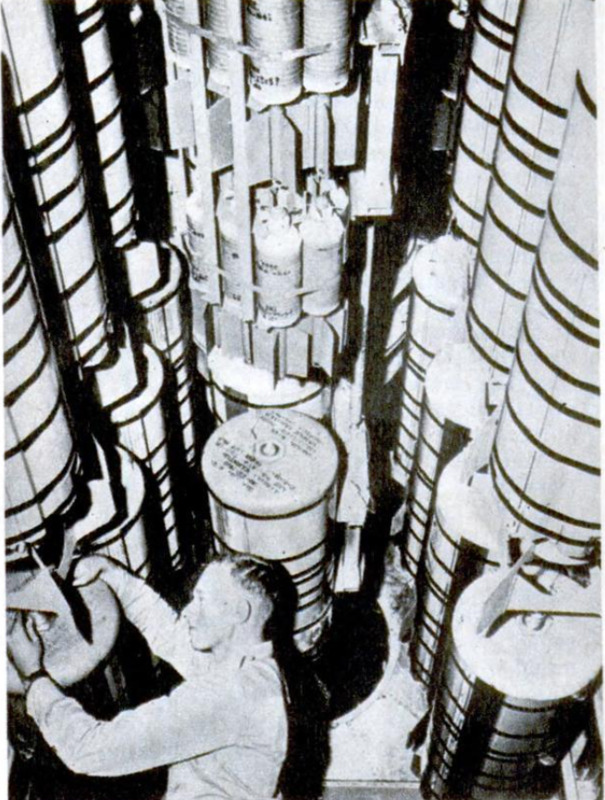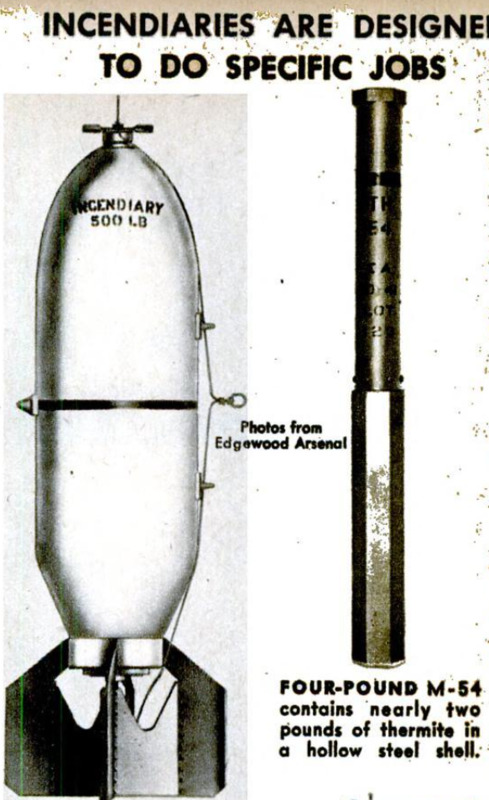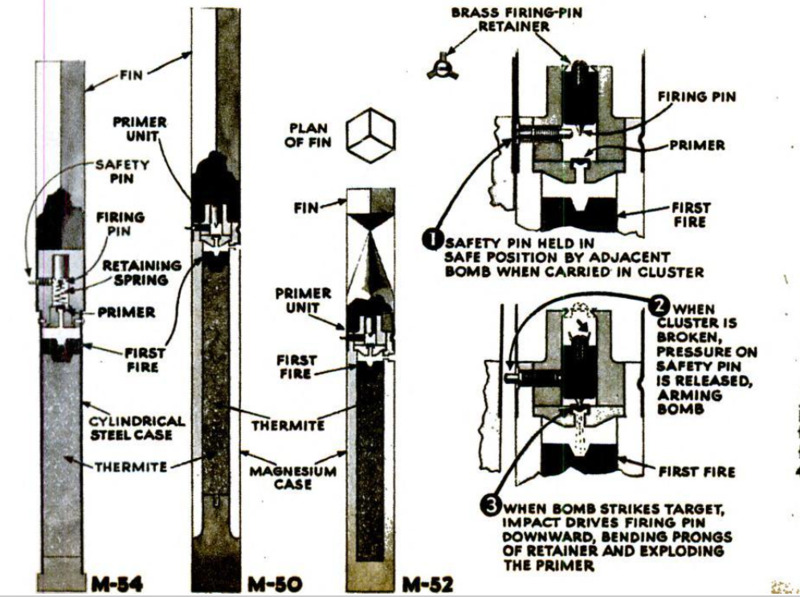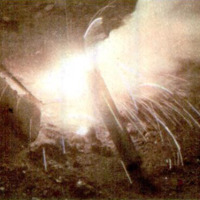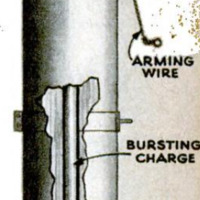-
Title (Dublin Core)
-
How we fight Japan with fire
-
Article Title and/or Image Caption (Dublin Core)
-
How we fight Japan with fire
-
extracted text (Extract Text)
-
WHEN America’s gel-gas incendiary
bombs streak out of & B20 fying high
above a Japanese arsenal, they look just
like gigantic explosive bombs. But as they
plunge toward the target, these big shell-
Tike cylinders burst open in the air, and out
ly dozens of clubs, nearly as big as base
ball bata.
Brigh-green ribbons pop out of one end
of each of these six-pound bludgeons. These |
ribbons, 40 inches long, reduce the rate of |
fall to from 225 to 250 feet per second
the speed that tests have shown to result
in’ the most effective ‘penetration of the
roofing of typical enemy buildings. So the
bombs tear through the arsenal roof more
Certainly than comets
“Then each bomb becomes an automatic
mortar. Tt falla over on ita side and les
ety ani time fuse inside fla hex:
agonal metal case touche off an explosion.
This blast shoots o sausage-shaped, cheese:
cloth bullet out of one end of the bomb
with enough force to. throw It from 25 to
100 yards.
“The seck Is full of sticky, gooey, yellow
jelly. As it ia shot out of the bomb, the |
sack is split open and its contents are Ig.
nited. Gob of flaming jelly are thus spat.
tered over everything in the vicinity. In an
attic, the fiery chunks of gel-gas are likely
Lo be hurled into the eaves, where fires are
hardest to put out. And sven when & bomb
falls in a street or alley, the incendiary fuel
i seldom wasted, for I then ia likely to bo
thrown on near-by walls and vehicles.
"This flrce fagot, However, is only one of
many types that have been developed by |
the U. 8 Chemical Warfare Service, headed
by Maj. Gen. William N. Porter, to enable |
American airmen to Aght fire with fire.
“The best warfare,” says a manual writ-
ten in the Fourth Century, B.C. “is that in |
which charms (chemicals) are used, the
next best s that in which mechanical instru.
ments are used, and the lowest is that in |
Which hands and hand-held weapons are |
used." New chemicals and new mechanisms
have been brought together in new fire
bombs.
The anclent art of
arson was first made
aerial by America’s on-
emies. German planes
blazed a flery path
across Europe for the
goose-steppers, and the
Jap bomb that fell in
Oregon in 42 was an
incendiary. But now,
thanks to the skillful
use of American re-
sources, the flames can
be turned the other
way.
U. 8. bombers at first
were loaded 10 times as
heavily with explosives
as with incendiaries.
But recent raiders have
carried twice as many
tons of incendiary as of
explosive material. The
emphasis has been re-
versed because flames
cause more widespread
and thorough damage
than blasts. Factories
that are merely blown
apart may be quickly
put-together again.
‘America’s Chemical
Warfare Service, In
fact, has been mainly
engaged in the produc-
tion of fire-spurting
weapons. And its ex-
ports at Edgewood Ar-
sonal, Maryland, com-
manded by Brig. Gen
Ray L. Avery, have
uperheated Liberty's
torches to destroy the
enemy's might for
Keeps.
The granddaddies of
modern aerial incendi-
rion, introduced by the
Germans in World War I, were about
the size of footballs and contained
gasoline. It burned so quickly that
often it only scorched things. The
Germans then developed magnesium-
thermite bombs. The Axis tried these
out in Ethiopia and Spain, and began
the second big war with great supplies
of highly developed metallic incendi-
aries. High explosives were hidden in
some of them to rout air wardens,
and the effectiveness of these fire-
works was speedily, amply, brutally,
and spectacularly demonstrated.
Experience convinced the British
that the most sure-fire bombs for all
Kinds of attacks were those made of
magnesium. But thermite, a mixture
of aluminum and iron oxide, also cre-
ates terrific heat. If a thermite bomb,
for instance, lands on an ofl tank, it
will scorch a hole in the top almost
a8 big as the bomb, and let red-hot
globules of metal drip into the interior.
The United States was drawn into
the war, however, without enough of
the stuff needed to make this kind of
bomb. This country produced only
6,250 tons of magnesium in 1940 and
needed that—and aluminum, toto
build planes. So something else had
to suffice for incendiaries.
~The heating capacity of materials is
measured in British Thermal Units (BTUs).
Each unit denotes the quantity of heat
needed to raise the temperature of one
pound of water one Fahrenheit degree.
Magnesium has about 10,800 BTU's per
pound, while crude oil has 19,500 and gas-
oline has 20,800. So the National Defense
Research Council, including such scientists
as Dr. Vannevar Bush of the Carnegie Insti-
tution, Dr. James B. Conant of Harvard,
and Dr. W. K. Lewis of Massachusetts In-
stitute of Technology, recommended that
the incendiary potentialities of petroleum
be reconsidered.
This suggestion led to the creation of
jellied oil, or gel-gas. It looks like mashed
potatoes well soaked with butter. It is
sticky, like rubber cement, and can be car-
ried in a sack, but when this sack is ignited
and split open, the gel flies out in ugly gobs
trailing long, streaming tongues of flame.
Magnesium, however, is much denser
than gasoline and is practically all radiant
energy. Magnesium became available again
after gel-gas had been produced. And the
Technical Command of the Chemical War-
fare Service, headed by Brig. Gen. William
C. Kabrich at Edgewood, then decided that
America ought to be armed with an incen-
diary having the destructive qualities of
both magnesium and gel-gas.
Col. Ralph W. Hufferd and others at
Edgewood insisted, in other words, on the
creation of a bomb filling that would (1)
spout flames like gasoline, (2) emit the
intense radiant heat of a burning metal,
(3) burn downward as well as upward, (4)
continue to burn and flare up for a consid-
erable time, and yet (5) be tough enough
to withstand an explosion.
These rigorous requirements have been
met with a new preparation that is called
pyrogel. A gob of this stuff, when dropped
on the floor, looks like a child's mud ple.
It is heavy, gray, and doughy. Much to the
annoyance of officers responsible for its
concoction, it is sometimes referred to as
“goop.” That is a slang term used in lab-
oratories to describe any miscellaneous,
sticky mass. Pyrogel ia sticky, but far from
miscellaneous.
It is, In fact, a very carefully and scien-
tifically planned pudding containing mag-
nesium, gel-gas, and other things. Like
radio performers who provide their own
applause, pyrogel
supplies itself with oxygen. A pound of this
stuff, furthermore, takes up only about two
thirds as much space as a pound of gel-gas.
Its viciousness is easier to demonstrate
than to explain. If few ounces of jellied
gasoline are placed in a corner and ignited,
flames leap up quickly and set fire to the
walls, The same volume of pyrogel, in the
same kind of corner, will not only ignite the
walls but also rapidly set fire to the floor.
The ash left by the pyrogel will be several
times the original volume of the material
and will burst into flame again when it falls
through the hole burned in the floor or is
disturbed in any other way.
If pyrogel is doused with water, it
snatches more oxygen trom the water and
burns more furiously. Chemical officers do
not know of any way to extinguish it. The
enemies against whom it is hurled may try
to move it away from combustible mate-
rials, but explosives as well as incendiary
fuel are packed into some pyrogel bombs.
So the firemen must risk being blown to
bits, or just wait until the mixture has
burned out, then try to quench the inferno
it has left.
The development of gel-gas and pyrogel,
however, is only part of the story. The
mechanisms invented to concentrate the
flames from these fuels on combustible ma-
terials are also something to keep Japs
awake nights. Gel-gas is put in tubes from
which it Is ejected explosively after being
dropped through a roof. And when such
firepots were hurled at the Japanese-occu=
pied city of Changsha, Chin. the result was
A conflagration that was visible for $0 miles.
For pyrogel. another type of miniature
volcano has been invented. No sack is placed
around the fuel in the bomb cylinder, and the missile's
descent is controlled by metal fins rather than by ribbon
streamers. Below the pyrogel there is a charge of white
phosphorus, a chemical that ignites when exposed to air
and stings whatever it hits. When the bomb strikes,
this white phosphorus shoots out of the tail with the
pyrogel, ignites it, and blankets the area with dense
smoke.
The fuse in this bomb is described by a conservative
former professor of chemistry as “Super-instantaneous.”
It is an all-ways fuse, which means that it goes off
regardless of the angle or direction from which the
bomb hits its target. It includes a striking pin enclosed
in a tiny oval compartment so designed that a jolt from
any direction hurls the pin against a percussion cap. The
timing of the explosion that hurls out the incendiary
pyrogel is so controlled, however, that the
bomb penetrates its target before sending
out a shower of flaming chemicals.
Both the gel-gas and the pyrogel bombs
are hexagonal-shaped pipes which can be
packed tightly Into ‘round clusters and
aimed with the bombsight in a plane. From
three to 16 dozen incendiaries, depending
on the size and type, constitute a cluster,
held together by iron bands. And when thus
bound into a bundle, a safety pin on one
side of each bomb prevents it from going off
prematurely.
These pins pop out when the cluster
comes apart during its descent. The cluster
is split open then by a rope of primacord
attached to a separate time fuse. This fuse
can be set 80 that the cluster will split open
at any desired altitude. Thus, a plane flying |
at a height of 20,000 feet may drop a
cluster of fagots that do not begin to scat-
ter until they are only 5,000 feet or so above
the target.
The use of these precisely controlled
clusters permits airmen to concentrate their
flery hailstorms on worth-while targets.
Sometimes, however, one big bomb can do |
more harm than scores of little bombs. So |
the Chemical Warfare Service supplies the
raiders not only with bundles of two-, four-, |
and six-pound bludgeons, but also with 100-
and 500-pound fire-starting bombs for use
on special targets.
The biggest incendiary now in regular
use is a quarter-ton block-burner full of
pyrogel. It looks like a thick, stubby cigar
and has two metal bands around its middle
to facilitate handling. This bomb has plenty
of penetrating power. After lunging into an
enemy installation, it squirts out a pillar
of fire which the devil himself must surely
admire.
-
Contributor (Dublin Core)
-
Volta Torrey (article writer)
-
William W. Morris (Photographer)
-
Robert F. Smith (Photographer)
-
Language (Dublin Core)
-
eng
-
Date Issued (Dublin Core)
-
1945-05
-
pages (Bibliographic Ontology)
-
100-103,106-109
-
Rights (Dublin Core)
-
Public domain
-
Archived by (Dublin Core)
-
Sami Akbiyik
-
Marco Bortolami (editor)
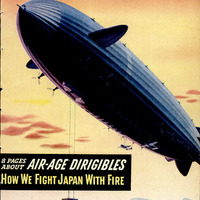 Popular Science Monthly, v. 146, n. 5, 1945
Popular Science Monthly, v. 146, n. 5, 1945

